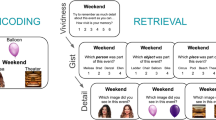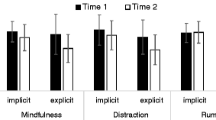Abstract
This study examined the links between implicit motives, pleasant experiences, and associated affect. Subjects high in the need for power (n Pow) or intimacy (n Int) recalled a pleasant or neutral personal experience. Consistent with past findings, content analyses revealed that recalled pleasant experiences reflected subjects, respective concerns for power and intimacy. Because the content of the pleasant memories ofn Pow andn Int subjects differed, their vivid recollections were also expected to produce different affective states. Analyses of self-report affect measures administered after the recall task showed thatn Int subjects who recalled a pleasant event expressed more happiness, elation, and friendliness. By contrast,n Pow subjects in the pleasant recall condition reported more excitation and anger. Findings suggest that positive affect inductions involving the vivid recall of idiographic material may lead to different specific affective states based on the content of those experiences and individuals’ capacity to experience and sustain particular affective states.
Similar content being viewed by others
References
Argyle, M., & Cook, M. (1976).Gaze and mutual gaze. Cambridge, England: Cambridge University Press.
Atkinson, J. W. (1958).Motives in fantasy, action and society. New York: Van Nostrand.
Bakan, D. (1966).The duality of human existence. Chicago: Rand McNally.
Blaney, P. H. (1986). Affect and memory: A review.Psychological Bulletin, 99, 229–246.
Forgas, J. (Ed.). (1991).Emotion and social judgements. Oxford, England: Pergamon.
Gerrards-Hesse, A., Spies, K., & Hesse, F. W. (1994). Experimental inductions of emotional states and their effectiveness: A review.British Journal of Psychology, 85, 55–78.
Gray, J. A. (1981). A critique of Eysenck’s theory of personality. In H. J. Eysenck (Ed.),A model for personality (pp. 246–276). New York: Springer.
Isen, A. M. (1984). Toward understanding the role of affect in cognition. In R. Wyer & T. Srull (Eds.),Handbook of social cognition (Vol. 3, pp. 179–236). Hillsdale, NJ: Erlbaum.
Larsen, R. J., & Ketelaar, T. (1989). Extraversion, neuroticism, and susceptibility to positive and negative mood induction procedures.Personality and Individual Differences, 10, 1221–1228.
Larsen, R. J., & Ketelaar, T. (1991). Personality and susceptibility to positive and negative emotional states.Journal of Personality and Social Psychology, 61, 132–140.
Larsen, R. J., Sinnett, L., & Kasimatis, M. (1988, April).Techniques of laboratory mood induction: A meta-analysis of 100 published studies. Paper presented at the meeting of the Midwestern Psychological Association, Chicago.
McAdams, D. P. (1982). Experiences of intimacy and power: Relationships between social motives and autobiographical memory.Journal of Personality and Social Psychology, 42, 292–302.
McAdams, D. P. (1984). Scoring manual for the intimacy motive.Psychological Documents, 14, 2614.
McAdams, D. P. (1985).Power, intimacy, and the life story: Personological inquiries into identity. Chicago: Dorsey Press.
McAdams, D. P. (1990).The person. San Diego: Harcourt, Brace, Jovanovich.
McAdams, D. P., Lester, R. M., Brand, P. A., McNamara, W. J., & Lensky, D. B. (1988). Sex and the TAT: Are women more intimate than men? Do men fear intimacy?Journal of Personality Assessment, 52, 397–409.
McAdams, D. P., Manfield, E. D., Day, R., & Hoffman, B. J. (1993).Themes of agency and communion in significant autobiographical scenes. Unpublished manuscript, Northwestern University, Evanston, IL.
McClelland, D. C. (1975).Power: The inner experience. New York: Irvington.
McClelland, D. C. (1980). Motive dispositions: The merits of operant and respondent measures. In L. Wheeler (Ed.),Review of personality and social psychology (Vol. 1, pp. 10–41). Beverly Hills: Sage.
McClelland, D. C. (1981). Is personality consistent? In A. I. Rabin, J. Aronoff, & R. Zucker (Eds.),Further explorations in personality (pp. 86–113). New York: Wiley.
McClelland, D. C. (1985).Human Motivation. Glenview, IL: Scott-Foresman.
McClelland, D. C. (1989). Motivational factors in health and disease.American Psychologist, 44, 675–683.
McClelland, D. C., Koestner, R., & Weinberger, J. (1989). How do self-attributed and implicit motives differ?Psychological Review, 96, 690–702.
Smith, C. P. (Ed.). (1992).Handbook of thematic analysis. Cambridge, England: Cambridge University Press.
Strack, F., Schwarz, N., & Gschneidinger, E. (1985). Happiness and reminiscing: The role of time perspective, mood, and mode of thinking.Journal of Personality and Social Psychology, 49, 1460–1469.
Velten, E. (1968). A laboratory task for induction of mood states.Behavior Research and Therapy, 6, 473–482.
Watson, D., Clark, L. A., & Tellegen, A. (1988). Development and validation of brief measures of positive and negative affect: The PANAS scales.Journal of Personality and Social Psychology, 54, 1063–1070.
Weinberger, J. & McClelland, D. C. (1991). Cognitive versus traditional motivational models. In E. T. Higgins & R. M. Sorrentino (Eds.),Handbook of motivation and cognition (Vol. 2, pp. 562–597). New York: Guilford Press.
Williams, J. M. G. (1980). Generalization in the effects of a mood induction procedure.Behavior Research and Therapy, 18, 565–572.
Winter, D. G. (1973).The power motive. New York: Free Press.
Winter, D. G. (1992). Power motivation revisited. In C. Smith (Ed.),Handbook of thematic analysis (pp. 311–324). Cambridge, England: Cambridge University Press.
Woike, B. A. (1992).A functional utility model of cognitive complexity. Unpublished doctoral dissertation. Michigan State University, East Lansing.
Woike, B. A. (1994). The use of differentiation and integration processes: Empirical studies of “separate” and “connected” ways of thinking.Journal of Personality and Social Psychology, 67, 142–150.
Woike, B. A. (1995). Most memorable experiences: Evidence for a link between implicit and explicit motives and social cognitive processes in everyday life.Journal of Personality and Social Psychology, 68.
Woike, B. A., & Aronoff, J. (1992). Antecedents of complex social cognitions.Journal of Personality and Social Psychology, 63, 97–104.
Zuckerman, M., & Lubin, B. (1985).Manual for the Multiple Affect Adjective Checklist-Revised. San Diego: Educational and Industrial Testing.
Author information
Authors and Affiliations
Additional information
I am grateful for helpful comments from Alice M. Isen, Dan McAdams, Mike DeBoer, and anonymous reviewers on earlier drafts of this article. The help of Chris Adams, Steve Dean, Brian Downey, Michelle Kallus, Amy Kief, Tom Osier, Camille Tower, and Felicia Wilson in coding the experimental data is also greatly appreciated.
Rights and permissions
About this article
Cite this article
Woike, B.A. Vivid recollection as a technique to arouse implicit motive-related affect. Motiv Emot 18, 335–349 (1994). https://doi.org/10.1007/BF02856473
Issue Date:
DOI: https://doi.org/10.1007/BF02856473




